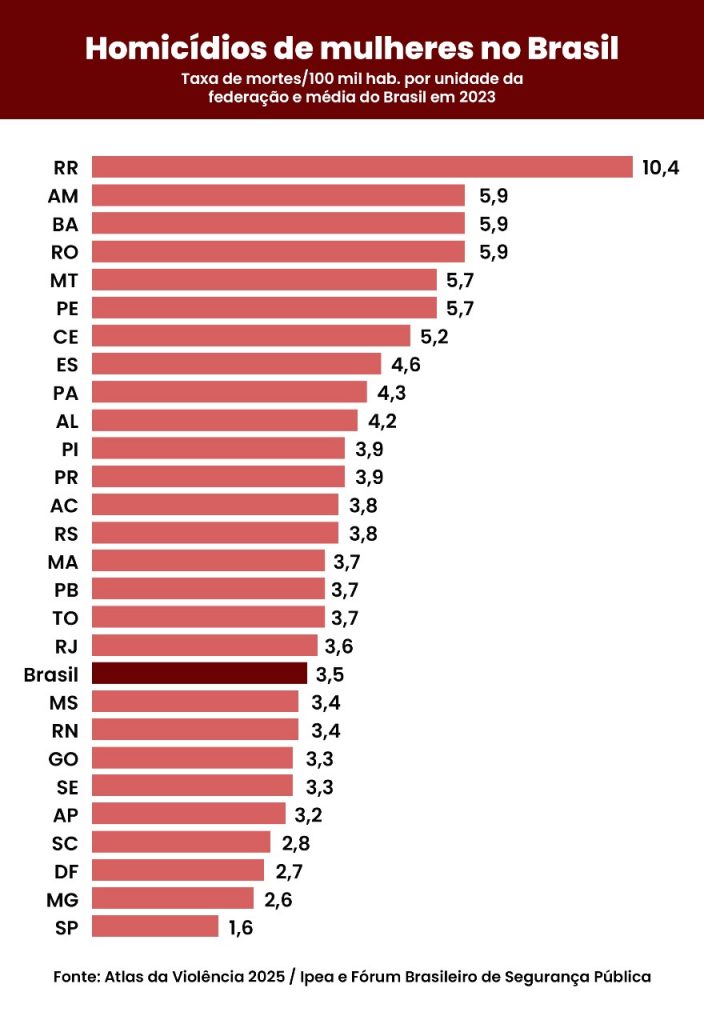States in the Amazon lead in female homicides in Brazil
13 de May de 2025

By Jadson Lima – From Cenarium
MANAUS (AM) – States in the Amazon region recorded the highest rates of female homicides in 2023, according to data from the Atlas of Violence 2025, produced by the Institute of Applied Economic Research (Ipea) and the Brazilian Forum on Public Security.
Roraima topped the ranking, with a rate of 10.4 deaths per 100,000 inhabitants – nearly three times the national average of 3.5. Amazonas, Bahia, and Rondônia also posted high rates, each with 5.9 deaths per 100,000 women. Mato Grosso also appeared in the ranking with 5.7, the same rate as Pernambuco.
Senior researcher at the Forum, Manoela Miklos, pointed out that each locality has its own specificities. In the case of Roraima, for example, the issue of illegal mining was taken into account. “We conducted a hypothesis study with Roraima involving the presence of mining, so it’s a job that requires close examination of each of these states to understand which specific phenomena keep these rates high,” said Manoela.
See the ranking:

Death rate/100,000 inhabitants per federation unit and average for Brazil in 2023
(Art: Lucas Oliveira/Cenarium)
In contrast, states in the Southeast and South registered the lowest female homicide rates. São Paulo had the lowest rate in the country, with 1.6 deaths per 100,000 inhabitants, followed by Minas Gerais (2.6) and the Federal District (2.7).
Lawyer Amanda Pinheiro, president of the Instituto As Manas, observes that violence against women results from a culture that objectifies them. “The patriarchal culture that roots education in machismo leads to women being objectified, seen as property of their partners, who do not accept them moving on with their lives after relationships end. Our population is of mixed origin between Indigenous peoples, Europeans, and Northeasterners, which shows that machismo and misogyny are a universal violation of human rights, with violence against women still being ‘tolerable and justifiable’ in society,” she declared.
The data from the Atlas of Violence are based on the Mortality Information System of the Ministry of Health. For this reason, there are differences between the numbers used in the study and the statistics published by state Public Security secretariats and research based on criminal data. The 2023 microdata from the Notification of Grievances Information System, also from the Ministry of Health and used for information on assaults, are still preliminary.
National
On the national level, reports of violence against women in Brazil increased in 2023, while homicide rates remained stagnant, despite an overall decline in murders in the country. There were 275,000 notifications of assault, compared to 221,000 in 2022.
The homicide rate remained at 3.5 deaths per 100,000 inhabitants in both years. Data from 2023 show 3,900 recorded homicides, a 2.5% increase from 2022, which had 3,800 victims.
Six out of ten cases of violence — 177,086 in total — occurred at home. Next came reports of community violence (59,611) — committed by people with no family ties, such as neighbours, colleagues, or strangers —, mixed violence (34,653), and institutional violence (3,925), where some type of hierarchy is involved.
All these categories saw increases when comparing 2022 to 2023.
Types of Violence
The most frequent form of violence in 2023 was physical (37.4%), followed by multiple forms (30.3%). Neglect accounted for 12% of cases, and psychological and sexual violence made up 10.1% and 9.5% of cases, respectively.
Over the course of life, neglect is the main form of violence against girls aged 0 to 9, accounting for 49.5% of cases. Sexual violence becomes most frequent between ages 10 and 14 (45.7%). From ages 20 to 69, physical violence is the most commonly reported. Neglect then becomes predominant again (33.3%) from age 70 onwards.
Race
In the racial breakdown, Black women are the most frequent victims of homicide, according to the Atlas, with 2,600 deaths, or 68.2% of cases. “The numbers reveal the tragic intersection between patriarchal culture and structural racism, both deeply rooted in Brazil,” the publication states.
The variation among the states also highlights the need for targeted public policies. This is the case with Roraima, for example, which has 10.4 female deaths per 100,000 inhabitants – well above the national average of 3.5.
“We conducted a hypothesis study with Roraima involving the presence of mining, so it’s a job that requires close examination of each of these states to understand which specific phenomena keep these rates high,” says Manoela.
(*) With information from Folhapress

